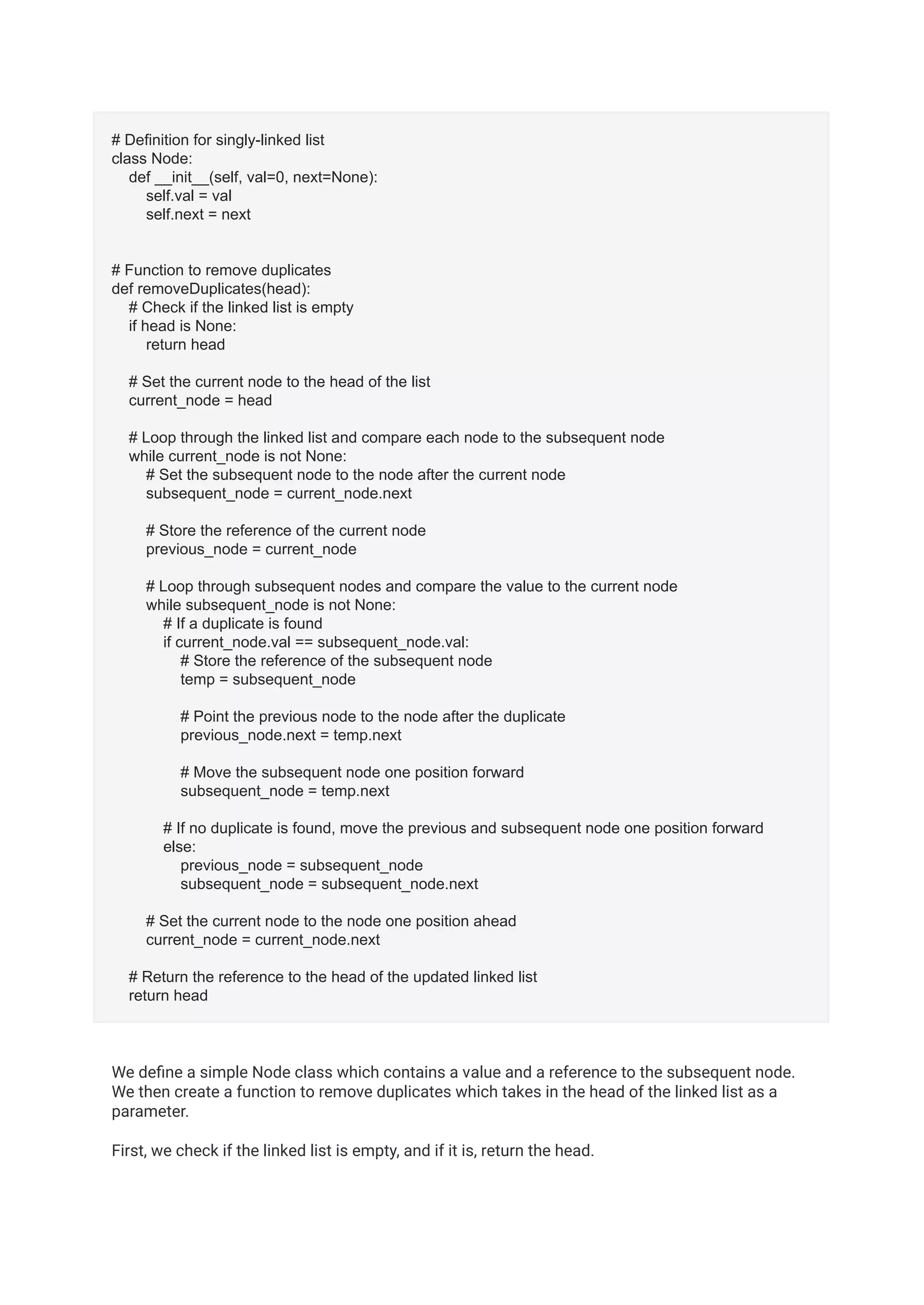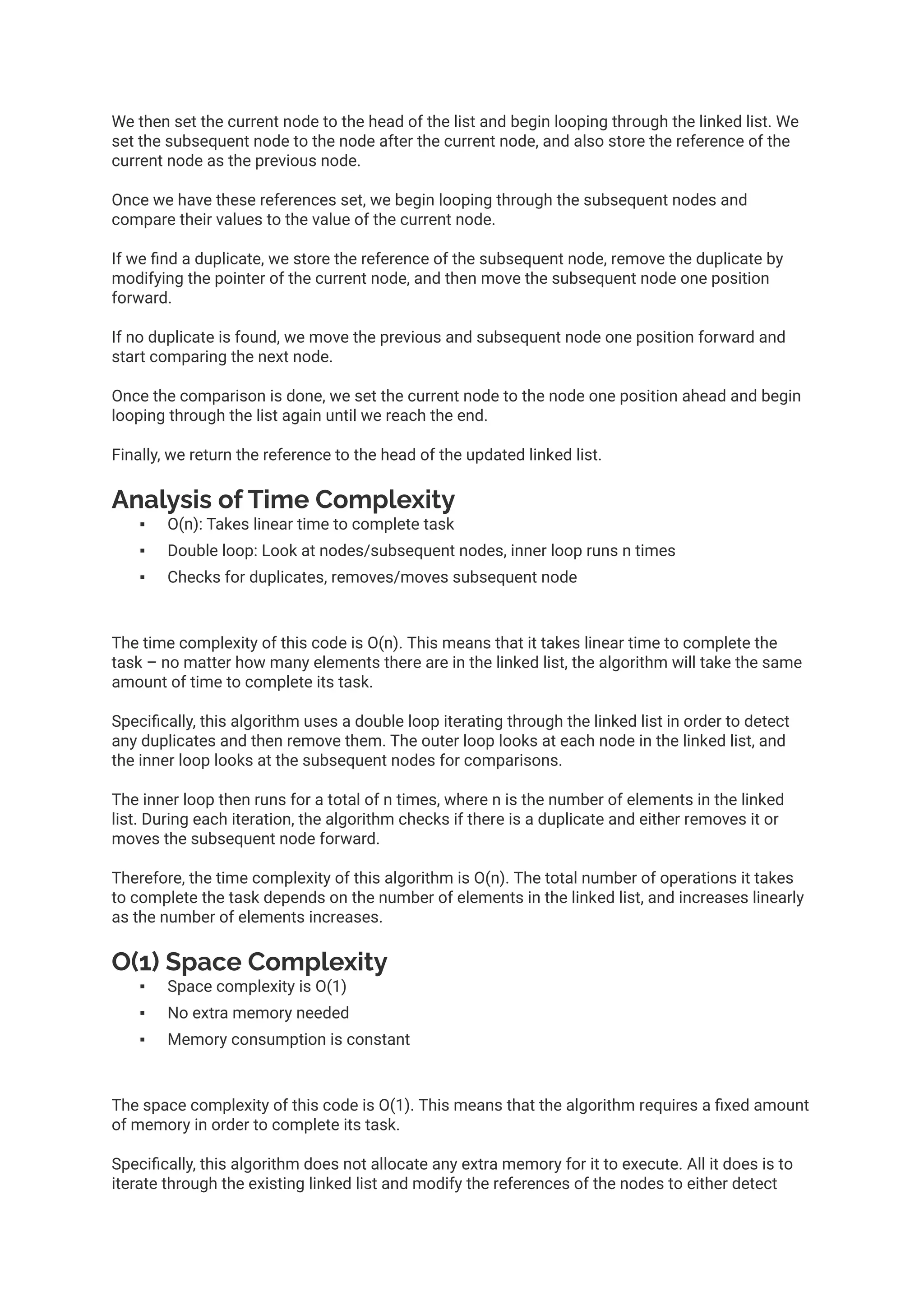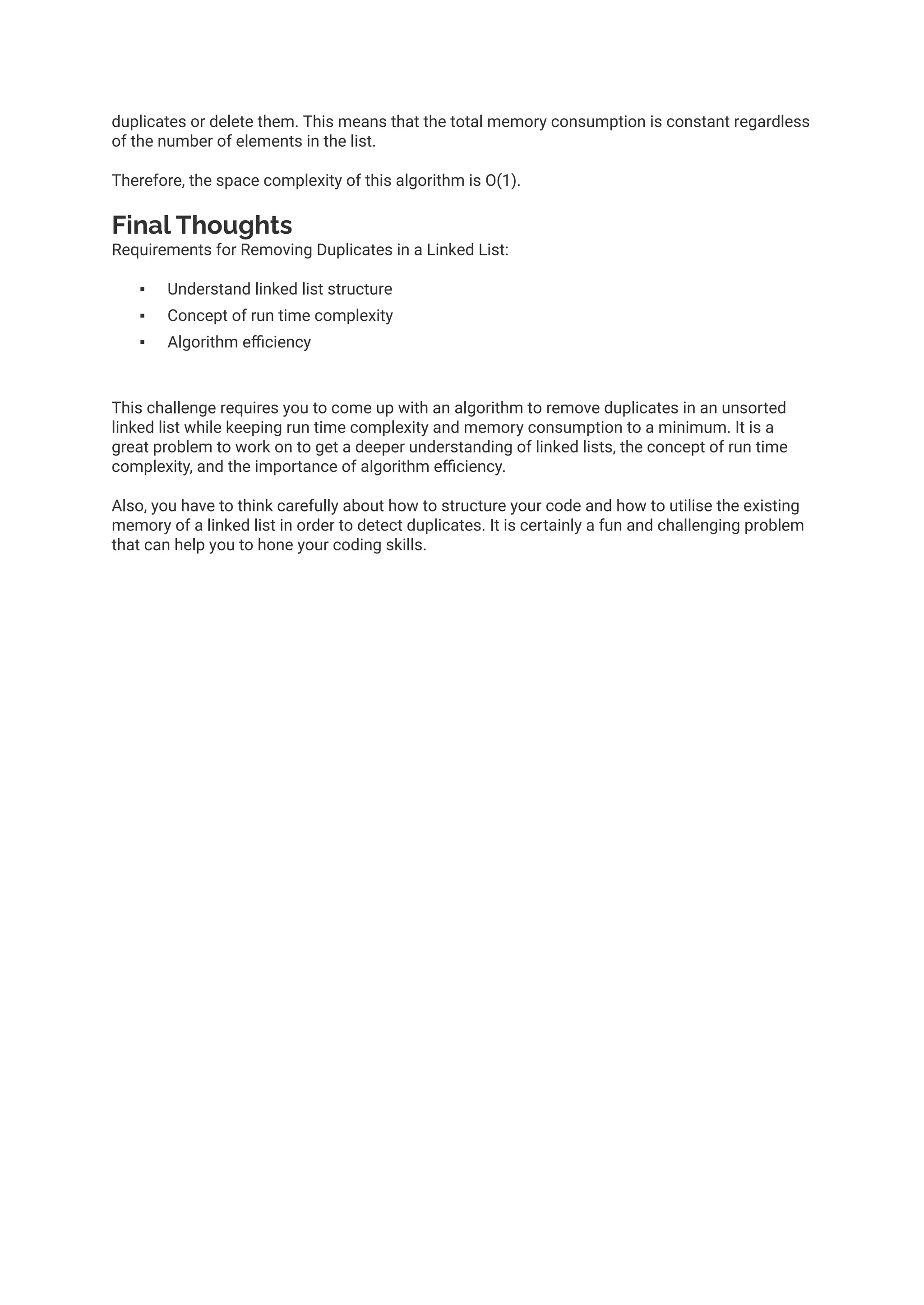The document discusses a Python coding challenge focused on removing duplicates from an unsorted linked list without sorting it or allocating extra memory, while maintaining a linear runtime complexity of O(n). It provides an overview of linked lists, necessary operations, and a detailed algorithm for duplicate removal, including a sample Python implementation. The algorithm efficiently traverses the list while modifying pointers to eliminate duplicates, ensuring both time and space complexities are optimal.
![Python Coding Challenges Python Link List Challenges
Remove Duplicates in an Unsorted Linked
List in Python
written by Kal Bartal February 6, 2023
Click to watch video tutorial on Removing Duplicates in an Unsorted Linked List in Python
Problem:
Given an unsorted linked list of integers, remove any duplicated nodes and return a reference to
the head of the updated linked list.
Constraints:
The linked list should not be sorted in place, and you are not allowed to allocate extra memory.
Your algorithm should have a run time complexity of O(n).
Example:
Input:
[1, 7, 3, 2, 3, 7, 1]
Output:
[1, 7, 3, 2]
Understanding the problem
This problem requires you to find and remove any duplicate elements in an unsorted linked list.
The linked list should not be sorted in place and you are not allowed to allocate extra memory.
Therefore, you will need to come up with an algorithm that scans the linked list, detects any
duplicates, and then removes them from the list.](https://image.slidesharecdn.com/removeduplicatesinanunsortedlinkedlistinpython-230206185658-f065c8ac/75/Remove-Duplicates-in-an-Unsorted-Linked-List-in-Python-1-2048.jpg)
![For example, given the following input of [1, 7, 3, 2, 3, 7, 1], the expected output should be [1, 7, 3,
2]. Notice that any duplication of 1 or 7 has been removed, resulting in the unique elements of the
list being returned as the output.
Your algorithm should have a run time complexity of O(n) – which means that it should be able to
work through the list of elements quickly, rapidly detect any duplicates, and then efficiently
remove them.
Solving this problem
To solve this problem, you must have a basic knowledge of linked lists and their associated
operations. You will also need to familiarise yourself with the concept of run time complexity and
how it relates to your solution.
While you are not allowed to allocate extra memory, you will need to understand the logic of how
to utilise the existing memory of a linked list in order to detect duplicates. Also, the algorithm
should be efficient and have a run time complexity of O(n).
Associated Operations on Linked Lists
Linked lists are data structures comprising of a sequence of interconnected nodes. Each node
stores a value, and additionally has a pointer pointing to the node containing the next value. The
nodes in a linked list are internally connected through these pointers.
The associated operations are the set of operations that can be performed on linked lists, given
their structure. These operations can include:
▪ Inserting a node
▪ Removing a node
▪ Finding a node with a given value
▪ Traversing the list to access individual nodes
For example, if you had a linked list of the numbers [1, 2, 3], each node would contain a single
value and a pointer pointing to the following node. This sequence of nodes and their respective
pointers would internally connect them together.
If you wanted to add the number 4 to this list, you could utilise the insert operation and add the
node containing 4 after the node containing 3. This would result in the new linked list of [1, 2, 3,
4].
As you can see, the operations of a linked list are useful in manipulating the order and content of
the individual nodes.
Examples:
▪ Inserting a node
▪ Removing a node
▪ Finding a node with a given value
▪ Traversing the list to access individual nodes](https://image.slidesharecdn.com/removeduplicatesinanunsortedlinkedlistinpython-230206185658-f065c8ac/75/Remove-Duplicates-in-an-Unsorted-Linked-List-in-Python-2-2048.jpg)
![Run Time Complexity
▪ Efficiency of an algorithm and duration of task completion
▪ Time to process input (O notation)
▪ Linear time with increasing elements (O(n))
Run time complexity refers to how efficient an algorithm is and how long it takes for the
algorithm to complete its task. It is measured by the amount of time needed for the algorithm to
process its input, and is commonly represented in the Big-O notation.
For instance, if an algorithm takes 10 seconds to process 10 elements, it would have a run time
complexity of O(10), meaning it takes 10 seconds to process 10 elements. On the other hand, an
algorithm with a run time complexity of O(n) would take linear time as the amount of elements
increase, i.e. if an algorithm takes 10 seconds to process 10 elements, it would take 20 seconds
to process 20 elements.
For this particular problem, you are expected to develop an algorithm with a run time complexity
of O(n), or linear time. This means that no matter how many elements are in the linked list, the
algorithm should take linear time to detect duplicates and remove them.
Detecting Duplicates in a Linked List
▪ Track existing memory of the linked list
▪ Compare each node’s value to the values of the nodes that follow it
▪ Modify pointer of node before duplicate to remove it from the list
The logic of utilising the existing memory of a linked list to detect duplicates is to keep track of
each node’s value and pointer. As you traverse the list, compare each node’s value to the values
of the nodes that come after it. If a duplicate is found, you can remove it by modifying the node’s
pointer before it.
For example, if the linked list you are traversing contains the elements [1, 7, 4, 5, 4], then you
would go through each node and compare the subsequent nodes to the node you are currently
at. In this case, when you reach the node containing the number 4, you would compare the next
node’s value to see if it is a duplicate. In this case, the subsequent node does contain the same
value of 4 so it can be identified as a duplicate.
Now, you can simply modify the pointer of the node containing the number 4 so that it points to
the node containing the number 5, instead of the duplicate node containing 4. This therefore
removes the duplicate from the linked list, leaving you with [1, 7, 4, 5] as the output.
Examples:
▪ If list is [1, 7, 4, 5, 4], compare the 4th node’s value to the subsequent one (the ‘4’)
▪ Modify pointer of 4th node so it points to the 5th instead of the duplicate node
Removing Duplicates in an Unsorted Linked List in
Python
Here is a Python solution to this problem which has a run time complexity of O(n)](https://image.slidesharecdn.com/removeduplicatesinanunsortedlinkedlistinpython-230206185658-f065c8ac/75/Remove-Duplicates-in-an-Unsorted-Linked-List-in-Python-3-2048.jpg)


